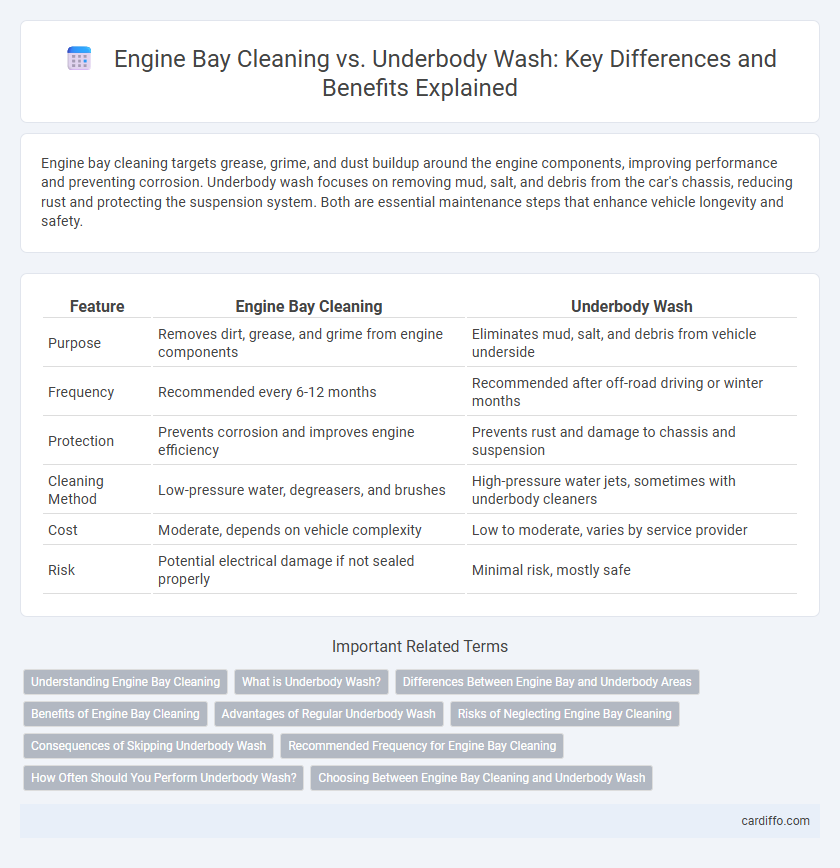Engine bay cleaning targets grease, grime, and dust buildup around the engine components, improving performance and preventing corrosion. Underbody wash focuses on removing mud, salt, and debris from the car's chassis, reducing rust and protecting the suspension system. Both are essential maintenance steps that enhance vehicle longevity and safety.
Table of Comparison
| Feature | Engine Bay Cleaning | Underbody Wash |
|---|---|---|
| Purpose | Removes dirt, grease, and grime from engine components | Eliminates mud, salt, and debris from vehicle underside |
| Frequency | Recommended every 6-12 months | Recommended after off-road driving or winter months |
| Protection | Prevents corrosion and improves engine efficiency | Prevents rust and damage to chassis and suspension |
| Cleaning Method | Low-pressure water, degreasers, and brushes | High-pressure water jets, sometimes with underbody cleaners |
| Cost | Moderate, depends on vehicle complexity | Low to moderate, varies by service provider |
| Risk | Potential electrical damage if not sealed properly | Minimal risk, mostly safe |
Understanding Engine Bay Cleaning
Engine bay cleaning involves removing dirt, grease, and debris from the engine compartment to improve performance and prevent corrosion. Proper cleaning techniques use degreasers and low-pressure water to protect electrical components while enhancing engine efficiency. Understanding engine bay cleaning helps maintain vehicle longevity and ensures optimal functioning of critical engine parts.
What is Underbody Wash?
Underbody wash is a specialized cleaning process that targets the vehicle's underside, including the chassis, suspension components, and wheel wells, to remove dirt, mud, salt, and road grime. This cleaning method prevents corrosion and rust, especially in regions with heavy snow or salted roads, by reaching areas typically missed during regular washes. Engine bay cleaning, by contrast, focuses on the compartment housing the engine, targeting oil residue, grease, and accumulated debris for maintenance and performance reasons.
Differences Between Engine Bay and Underbody Areas
Engine bay cleaning targets the compartment housing the vehicle's engine, focusing on removing grease, oil, and dirt that accumulate on sensitive mechanical and electrical components. Underbody wash concentrates on the vehicle's underside, addressing mud, salt, and road grime that can cause corrosion and damage to the chassis and suspension. These distinct areas require different cleaning techniques and products to effectively protect and maintain vehicle performance and longevity.
Benefits of Engine Bay Cleaning
Engine bay cleaning removes dirt, grease, and debris that can cause overheating and reduce engine efficiency. It improves the lifespan of engine components by preventing corrosion and buildup that impact performance. A clean engine bay also makes it easier to spot leaks and potential mechanical issues early, ensuring better vehicle maintenance.
Advantages of Regular Underbody Wash
Regular underbody wash effectively removes corrosive salt, mud, and grime that accumulate beneath a vehicle, preventing rust and extending the lifespan of critical components like the exhaust system and brake lines. This maintenance practice enhances overall vehicle safety by reducing the risk of mechanical failures caused by hidden damage. Compared to engine bay cleaning, underbody wash directly protects the structural integrity and undercarriage parts subject to harsh road conditions.
Risks of Neglecting Engine Bay Cleaning
Neglecting engine bay cleaning can lead to the accumulation of dirt, grease, and debris that may cause overheating, electrical issues, and corrosion of critical components. Unlike underbody wash, which primarily removes road grime and salt deposits affecting the vehicle's chassis, skipping engine bay maintenance increases the risk of engine damage and reduced performance. Regular cleaning of the engine bay ensures optimal heat dissipation and prevents costly repairs linked to neglected grime buildup.
Consequences of Skipping Underbody Wash
Neglecting an underbody wash leads to the accumulation of salt, mud, and corrosive debris that accelerates rust and damages essential components like brake lines and suspension parts. Unlike engine bay cleaning, which primarily targets the visible mechanical parts, underbody washing protects the vehicle's structural integrity and enhances longevity. Ignoring this maintenance can result in costly repairs and reduced vehicle safety over time.
Recommended Frequency for Engine Bay Cleaning
Engine bay cleaning is typically recommended every 12 to 18 months to prevent grease and dirt buildup that can affect engine performance and component longevity. Underbody washes, focused on removing road salt and debris, should be done more frequently, ideally every 1 to 3 months depending on driving conditions. Maintaining a regular engine bay cleaning schedule ensures optimal engine health and reduces the risk of corrosion and mechanical issues.
How Often Should You Perform Underbody Wash?
Underbody washes should be performed every 3,000 to 5,000 miles or at least twice a year to prevent rust, corrosion, and buildup of road salt and grime. Frequent undercarriage cleaning is essential in regions with harsh winters or off-road driving, where exposure to mud, salt, and debris accelerates deterioration. Maintaining a regular underbody wash schedule protects critical components like brake lines, suspension parts, and the exhaust system, enhancing vehicle longevity and safety.
Choosing Between Engine Bay Cleaning and Underbody Wash
Choosing between engine bay cleaning and underbody wash depends on the vehicle's maintenance needs and environmental exposure. Engine bay cleaning targets dirt, oil, and grime buildup affecting engine performance, while underbody wash removes salt, mud, and debris that cause rust and corrosion on the chassis and suspension components. Prioritizing engine bay cleaning benefits vehicles prone to overheating and mechanical issues, whereas underbody wash is crucial for cars driven in snowy or off-road conditions to extend structural longevity.
Engine Bay Cleaning vs Underbody Wash Infographic

 cardiffo.com
cardiffo.com